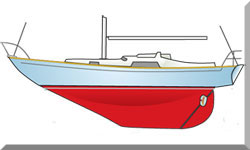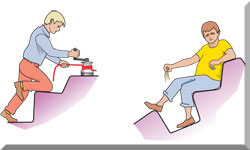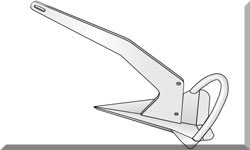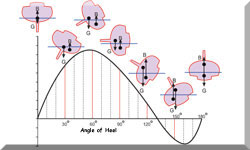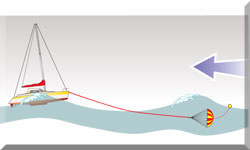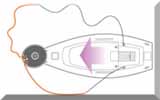- Home
- Knots, Bends & Hitches
- Reef Knot
The Reef Knot Knot
How to Tie It & When to Use It
The Reef Knot, also known as the Square Knot, got its name through its nautical use of being tied around a reefed sail. While adequate for that purpose isn't a knot to which much tension should be applied; in fact it will reduce the strength of a line in which it's tied by around 55%.
Tied incorrectly it will become the even more inferior Granny Knot,
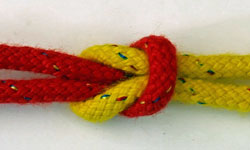
but remember the well-known mnemonic and you'll get it right every time:
'Left over right and under; right over left and under'.
You'll immediately know if you've made a mistake as a correctly tied reef knot can been seen as two bights cow-hitched together, as shown here.
How to Tie the Reef Knot
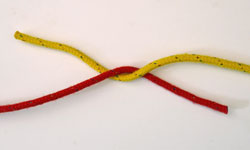
Stage 1
Remember the mnemonic?
Left over Right and Under;
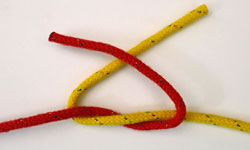
Stage 2
Right over Left...
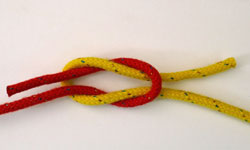
Stage 3
...and Under.
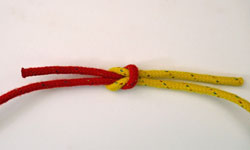
Stage 4
Cinch it up tight and you have your finished Reef Knot.
People also asked...
What is the purpose of a reef knot?
What is the purpose of a reef knot?
The reef knot, also known as the square knot, is a simple and widely used knot. Its primary purpose is to join two ropes or pieces of string together. It's often used in situations where the knot does not need to bear heavy loads. Here are a few common uses:
- First Aid: Used to tie bandages.
- Sailing: Securing sails and lines.
- Scouting: One of the basic knots taught to scouts.
- Parcel Tying: Keeping packages securely closed.
However, it’s important to note that a reef knot is not suitable for critical applications requiring strong and secure fastening, as it can slip under tension.
Can a reef knot come undone?
Can a reef knot come undone?
Yes, a reef knot can come undone, especially when subjected to certain conditions. Its structure is such that it can slip or capsize if not properly tightened, or if it experiences significant movement or load. Factors that can cause a reef knot to come undone include:
- Uneven Load: If the ropes are not equally loaded, the knot can slip.
- Slippery Material: Smooth or slippery rope materials, such as nylon, can cause the knot to loosen.
- Reversal of Load: If the load on the knot is reversed, it may capsize and come apart.
Because of these potential issues, a reef knot is best used for binding or securing items that won't be under significant stress or movement.
What is the difference between Granny and reef knot?
What is the difference between Granny and reef knot?
The granny knot and the reef knot (or square knot) are similar in appearance but have key differences in structure and functionality:
Structure:
- Reef Knot: Formed by making two overhand knots, with the second one going in the opposite direction of the first (right over left, then left over right, or vice versa).
- Granny Knot: Formed by making two overhand knots, but both in the same direction (right over left and right over left, or left over right and left over right).
Security:
- Reef Knot: More secure and less likely to slip when tied properly. It lies flat and is generally neat.
- Granny Knot: More prone to slipping and can easily come undone. It often twists and does not lie flat.
Common Use:
- Reef Knot: Used for binding and securing items that are not under significant strain or movement. It is commonly used in first aid, sailing, and parcel tying.
- Granny Knot: Generally considered a mistake or an inferior knot. It is often accidentally tied when attempting to make a reef knot or other knots.
No one would ever tie a granny knot intentionally!
Why do they call it a granny knot?
Why do they call it a granny knot?
The term "granny knot" is believed to come from the notion that it's an inferior or less effective knot, sometimes tied accidentally when trying to make a more secure knot like the reef knot. The name suggests it’s the kind of knot an inexperienced person (like someone's grandmother, in the traditional sense) might tie.
In knot-tying, a granny knot is often seen as a mistake rather than a deliberate choice, as it is prone to slipping and coming undone under tension. This is in contrast to the reef knot, which is more secure when tied correctly.
How to avoid tying a granny knot?
How to avoid tying a granny knot?
To avoid accidentally tying a granny knot, follow these steps carefully:
- Understand the Structure: Know that a reef knot is tied by crossing the ropes in opposite directions (right over left, then left over right). A granny knot results from repeating the same direction twice.
- Focus on the Overhand Knots: When you make the first overhand knot, take a moment to ensure you cross the ropes correctly in the second knot.
- Practice Deliberately: Practice tying the reef knot slowly and deliberately until it becomes second nature. Here’s a simple guide:Cross the right end over the left end and tuck it under, forming the first overhand knot.Next, cross the left end over the right end and tuck it under, forming the second overhand knot.
- Check Your Work: After tying the knot, visually inspect it. A proper reef knot will lie flat and appear symmetrical, whereas a granny knot will look twisted and uneven.
Recent Articles
-
Is An SSB Marine Radio Installation Worth Having on Your Sailboat?
Apr 14, 25 02:31 PM
SSB marine radio is expensive to buy and install, but remains the bluewater sailors' favourite means of long-range communication, and here's why -
Correct VHF Radio Procedure: Your Questions Answered
Apr 14, 25 08:37 AM
Got a question about correct VHF radio procedure? Odds are you'll find your answer here... -
VHF Marine Radio; Which One is Right for Your Boat?
Apr 14, 25 05:09 AM
If you're looking to buy a VHF Marine Radio the choice can be a bit overwhelming. So what should it be, a fixed VHF or a handheld VHF? Maybe one with AIS or GPS built in perhaps?


